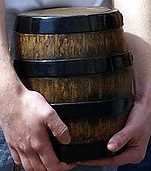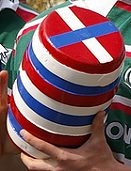|
Easter Monday
|
|||||
Woodlands Junior School is in the south-east corner of England |
|||||
|
Easter Monday, another UK Public Holiday, has little religious significance but is the occasion for numerous secular customs. Egg rolling Egg rolling is very popular in England and the rest of the UK and is an Easter Monday sport. Hard-boiled eggs are rolled down a hill. Customs differ from place to place. The winner's egg may be the one that rolls the farthest, survives the most rolls, or is rolled between two pegs. Biddenden Dole At Biddenden in Kent, the Biddenden Dole, in the form of bread, cheese, tea (formerly beer) and cake is distributed. The cake bears an image of two women said to be the founders of this charity, a pair of Siamese twins who were born in 1100 and died within a few hours of each other at the age of 34. Hare Pie Scramble and Bottle Kicking At Hallaton in Leicestershire, the Hare Pie Scramble and Bottle Kicking, an unruly rugby game between the village of Hallaton and Medbourne, takes place every Easter Monday. Hallaton is picturesque village with lots of old thatched cottages and set in beautiful countryside. Small wooden barrels filled with ale are used as rugby balls in the no-holds barrel contest, the object of which is to get each of the three casks to a touchline in either village.
One of the barrels is brightly painted in red, white and blue.
The history behind the Hare Pie Scrambe and Bottle Kicking The custom dates back to 1770, the Rector of Hallaton was allotted a piece of land on condition that he provided two hare pies, two dozen loaves of bread and a quantity of ale, which has to be scrambled for in public.
The game Two teams fight over three small beer barrels, in an attempt to get each barrel across the stream in their village by any means possible. The two teams are the Hallaton team, made up exclusively of villagers, and the Medbourne team, open to anyone. The Hallaton side try to get the barrels down the hill and over the stream behind the Bewick Arms, whilst the Medbourne team try to get the barrels over the fields for a mile or so towards their village. The game is played as a best of three with one barrel in playat a time. It is a very tough contest that can last for hours, crossing numerous hedges, lanes, ditches and even barbed wire to reach their touchlines. World Coal Carrying Championship On Easter Monday, The World Coal Carrying Championship takes place in the village of Gawthorpe, in Yorkshire. Contestants run for one mile, carrying a 50kg bag of coal. History behind the custom www.gawthorpe.ndo.co.uk/coal.htm London Harness Horse Parade- Easter Monday |
|||||
|
© Copyright Mandy Barrow 2013
Mandy is the creator of the Woodlands Resources section of the Woodlands Junior website.
The two websites projectbritain.com and primaryhomeworkhelp.co.uk
are the new homes for the Woodlands Resources.
Mandy left Woodlands in 2003 to work in Kent schools as an ICT Consulatant.
She now teaches computers at The Granville School and St. John's Primary School in Sevenoaks Kent.





 bagpipes and drums.
bagpipes and drums.  ©
© 






